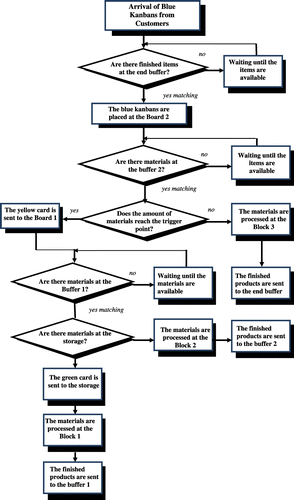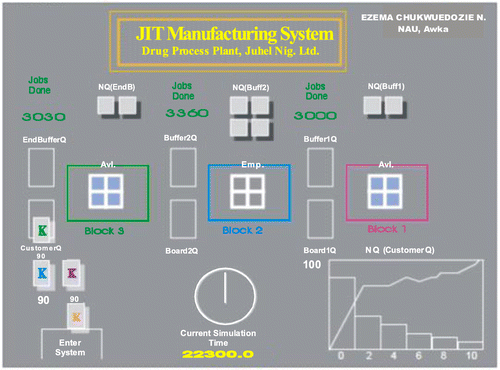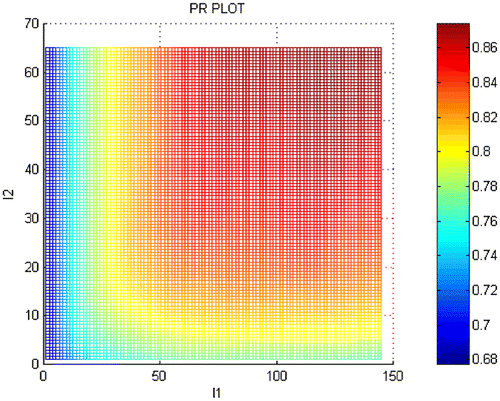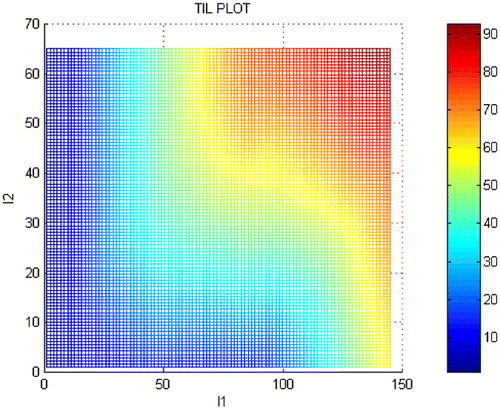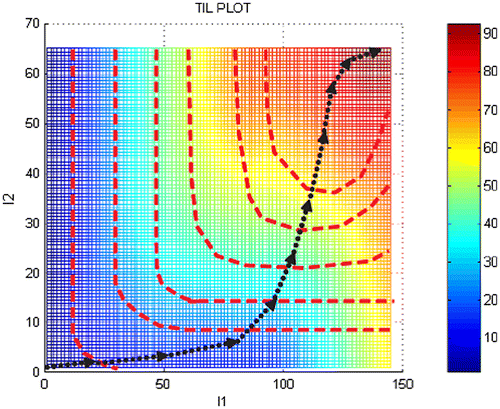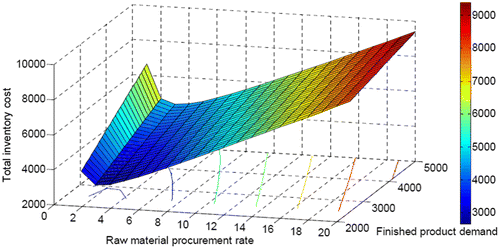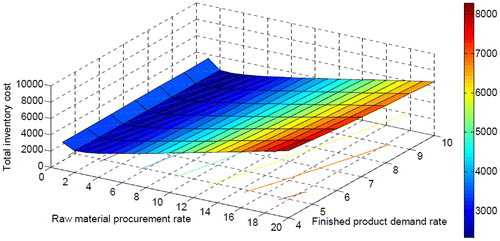Abstract
A Just-in-Time (JIT) Material Handling System attempts to manufacture products from start to finish by rearranging the factory floor layout away from batch production toward a product layout using flow lines. One of the most accepted JIT production methods used in this work is known as the Kanban system. Kanbans are used to operate a pull system of material control that links all supplying operations to a final assembly line. The ultimate goal of this system is the conversion of raw materials at the Juhel Oral Drug Process plant into finished products with lead time equal to processing time. The flows in the manufacturing model include: the flow of materials, the flow of information, and the flow of cost. These flows create the value streams. Components of the value stream can be value-add or waste, depending on the operating conditions. The simulation model developed in this research work is based on the single-card pull system developed at the Drug Process Plant. This model consists of three blocks (workstations) where there is a buffer located between two workstations. In this model, the material moves according to the Kanban rule. If Kanbans arrive and the material is available, the workstation starts processing the material. This research demonstrates that the design of the JIT system can significantly affect key manufacturing performance measures. JIT implementation cannot provide significant benefits if setup time and variability remain high as well as if the company is not able to optimise the production facilities by product mix. Based on the result from this work, JIT is not based upon rigid concepts. Therefore, successful implementation depends largely on the company’s ability to identify problems, creativity and efforts. The application of single-card pull system coupled with the use of the trigger point results in simpler mechanisms for operating the system.
Public Interest Statement
A Just-in-Time (JIT) Material Handling System works on a demand-pull basis, all goods made would be sold, and thus it incorporates changes in demand with surprising ease. This makes it especially appealing today, where the market demand is volatile and somewhat unpredictable. JIT manufacturing mechanisms presented in this paper encourages the “right first time” concept, so that inspection costs and cost of rework is minimized. High quality products and greater efficiency can be derived from following a just-in-time production system. Close relationships are fostered along the production chain under a just-in-time manufacturing system. Constant communication with the customer results in high customer satisfaction. Overproduction is eliminated when JIT manufacturing is adopted. The results show that in a JIT-Kanban based production system, the finished product demand (DF) is a vital factor and establish the on-hand inventory, especially when finished product demand shifts significantly influence the overall inventory cost. The research work will be beneficial to all manufacturing organizations including small scale business and large corporations.
1. Introduction
According to Doll and Vondermbse (Citation2011), Just-in-Time (JIT) attempts to manufacture products from start to finish, the first step in applying JIT production, is to reorganize the factory floor layout away from batch production toward a product layout using flow lines. In addition, each flow line will normally be U-shaped. This layout allows workers to help other workers if any trouble occurs in the production line and enhance access to more than one machine. If any problems come up during the production flow, the entire line shuts down, and the problem is resolved immediately. Since parts are produced based on demand, there is a constant flow of components rather than batches of work-in-progress (WIP). Under JIT environment, defective parts must be removed. When only minimum levels of inventories are allowed, any hold up in the production process may cause delays in customers’ deliveries. Doing the job right the first time is one of the main emphases of JIT production (Doll & Vondermbse, Citation2011).
One of the most conventional JIT production methods used is known as the Kanban system. Neumann and Jaouen (Citation2016) posited that “Kanban, the Japanese word for card originated from the use of cards to operate ‘a pull system’ of material control that connected all supplying operations to a final assembly line.” Furthermore, the ultimate goal of this system is the conversion of raw materials into finished products with lead time equal to processing time. Kanban attempts to achieve this goal by concentrating on the following areas: reduction of inventory and lot sizes; reduction of setup costs; elimination of queues; providing effective maintenance programs to eliminate production defects entirely (improving quality); reducing lead times; making vendors part of the team in terms of planning needs and delivery times; and minimizing employee turnover through consensus management, Neumann and Jaouen (Citation2016). An analysis of these factors with the typical traditional manufacturing philosophy discloses why JIT implementation in Nigeria has been a slow process. Inventory is regarded as an asset in an ordinary manufacturing plant, and the plant strives to produce more, just in case, any manufacturing problems arise (Robinson & Timmerman, Citation2014). Formulas are used to determine optimum lot sizes based on the trade-off between cost of inventories and the cost of setup, and no attempts are made to reduce these lots. Setups costs are not considered very important, as usually the plant’s main goal is to maximize output. Investment in queues is necessary since queues permit successive operations to continue in the event of a problem with the feeding operations. Vendors are considered adversaries, and competition between them is encouraged. Defective components are tolerated, and techniques are developed for estimating future production of scrap. Equipment repairs are done as necessary and it is not decisive because queues are available. Also traditional manufacturing entertain longer lead time.
Furthermore, workers do not have much input regarding new systems installed. However, they are evaluated based on those new systems. It is apparent from this discussion that most of the goals of a Kanban (JIT) system disagree with the traditional manufacturing or management philosophies of a typical manufacturing company. Hence, implementation of Kanban or other JIT processes involves considerable changes in the way companies are used to operating. According to Papadopoulus, Heavey, and Browne (Citation2013), successful implementation of JIT must entail a total commitment of the firm’s top management and employees. The implementation of JIT in the purchasing area is dependent on the availability of raw materials from suppliers just when they are wanted by the company. Under this kind of setting, a company must build up a very close relationship with its vendors in order for them to deliver quality parts on time.
2. Methodology
2.1. Structure of the JIT manufacturing system model
The manufacturing model consists of three flows: the flow of materials, the flow of information, and the flow of cost. These flows create the value streams. Components of the value stream can be value-add or waste, depending on the operating conditions. For instance, excess material flows become a stream of inventories, while excess information leads to uncertainty in process execution. By managing the flows, we can control the streams. An efficient control of these streams is essential for lean production.
As pointed out earlier, the interfaces control the flow. For instance a conveyor regulates the flow of materials and a visual control regulates the flow of information between two stations. The interfaces arise from disconnected points in the system, e.g. the physical distances between two machines, the communication barriers between two people, or the control panels between a machine and an operator. It is often a good location for cost transactions.
In the JIT Manufacturing System model, the parts represent the materials, while the Kanban represent the information mechanism. In this way, we can analyze the efficiency of these flows. Associated with each device that handles the parts or Kanban, a cost is applied to the operation of the device. Therefore a buildup of parts and Kanban implies an increasing cost.
The entities of the model are parts, Kanban, and cycles. Parts are produced in the production sub-model and they are consumed in the consumption sub-model. Parts are shipped from the production sub-model to the consumption sub-model. The parts travel through the supplier sub-model, and the plant sub-model while on transit. Kanban controls the reordering of parts. All Kanban cards start and end in the Kanban sub-model. Parts and Kanban cards from the supplier sub-model are transported to the plant sub-model. Cycle entities signal the transport cycles and they only exist in the route sub-model; they specify the time to dispatch.
2.2. System flows
As stated earlier, Kanban controls the reordering of parts. The Kanban cards flow pattern is described below: A Kanban card is issued in the Kanban sub-model when inventory level hits a critical point. At a specific time, the card will be picked up and transported to its designated supplier. The card is dropped off at the supplier. The card stays at supplier for a number of cycles to simulate the order-to-pickup lead time. After that, another card is pulled out together with any available parts assigned to the card. The card is then returned to the plant and dropped off. The card is sent back to a HOLD block which collects all the extra cards, i.e. a collection bin.
The parts are created at the supplier. The flow of parts is as follows: A prototype part duplicates another part once a Kanban signal is issued. This takes place at the same instant that the Kanban card is issued for the Kanban flow. The part is deferred in a process block to simulate production or dispensing. It then exits to a batch block and turn out to be part of a pallet. The pallet is picked up at a specific time and travel together with its Kanban card to the plant. At the plant the pallet is dropped off and moved to a holding block in the consumption sub-model.
2.3. Purpose of the evaluation of the new system
The purpose of the evaluation of the JIT system using simulation is to determine factors contributing to improving performance of the new system. The design of the new JIT system was carried out in a more practical rather than theoretical manner. Therefore, some JIT characteristics such as the number of buffers, Kanban quantities and the number of Kanban at each block are determined using practical grounds. In this research work, four characteristics will be evaluated using simulation to achieve lower inventory and shorter flow time. These include:
| (a) | The number of buffers | ||||
| (b) | The location of buffers | ||||
| (c) | Kanban quantities | ||||
| (d) | The scheduling rule | ||||
2.4. System simulation
The simulation model developed in this research work is based on the single-card pull system developed at the Drug Process Plant. This model consists of three blocks (workstations) where there is a buffer located between two workstations. In this model, the material moves according to the Kanban rule. Material processing is initiated at the workstation when Kanban’s arrive and the material is on hand. Otherwise, if the material is not on hand, the Kanban waits until the buffer is refilled and the material is available. To run this model, in the start of the simulation, all buffers hold a particular number of materials as the initialization. Without this step, the simulation in no way takes place since the materials are not on hand.
In this research work, not all items produced by the Drug Process Plant will be simulated since there are around 97 periodical items of which the order quantities range from one sub-pallet to 700 sub-pallets. In the simulation model, several high-volume items are selected to represent the other Kanban items. The rest are represented by four hypothetical non-Kanban items that have total order volumes and total processing times the same as those represented. Three stages are required to model the JIT system at the Drug Process Plant:
| (a) | Building the basic model and the animation. | ||||
| (b) | Developing a more realistic model by extending the number of items represented and the parameters of the system. | ||||
| (c) | Evaluating the actual system by increasing the number of buffers and throughput. | ||||
2.5. Building the basic model and animation
The objective of this stage is to develop the basic model and to verify the logic of the model. Item represented is only the trial item i.e. JBF 113104. The logic of this model can be established early due to its simplicity. The flow diagram describing this model is shown in Figure .
As the program is simple and the number of entities existing in the system is small, the verification of the logic of the model, particularly the movement of the entities can be conducted easily using animation. In the animation, it is difficult to observe the movement of too many entities on the same screen.
2.5.1. Pull mechanisms
The pull mechanism is created by using MATCH, a SIMAN block, as suggested by Pegden, Denis, and Randall (Citation2011). Fundamentally, there are many ways of simulating the pull mechanism, however, MATCH has the advantage that this mechanism can be easily animated using SIMAN. Basically the purpose of MATCH is to synchronize two or more randomly arriving entities. In the model file, two randomly arriving entities that will be matched are Kanbans and materials. By using MATCH, the materials will be sent to the next process only if there is an entity represented as a Kanban staying in the other queue. As written in the model file, an example of this mechanism is as follows:
Board2 QUEUE, Board2Q:
DETACH;
Buff2 QUEUE, Buffer2Q:
DETACH;
MATCH, Buff2, Block3:
Board2;
2.5.2. Trigger point
A trigger point is also represented in this stage since block 3 and block 2 have different batch sizes. Based on this concept, buffer 2 will be refilled if the cumulative number of parts has reached the batch size of block 2 (360 units). To simulate the trigger point, an entity denoted by a green Kanban will pick up (match) the materials from buffer 2. When the number of materials picked up reaches 60 units (represented by two entities) at the first trial, an entity represented by a yellow Kanban will be sent to block 2 to start producing 360 units of the new parts. If in the next trial, another entity denoted by a green Kanban arrives and the materials available at buffer 2 are more than 60 units, the yellow Kanban is not issued until the total requirement achieves 360 units or until the materials available are less than 60 units. This mechanism will ensure that there is a sufficient amount of materials consumed by block 3 and the pull system runs smoothly. In the model file, an example of this mechanism is shown as follows:
X(5)=X(5)+1:
X(6)=X(6)+Type;
BRANCH, 1:
IF,(X(6).ge.2).and.(X(5).eq.1),label1:
IF,(X(6).ge.12).and.(X(5).eq.2),label1:
ELSE,label2; ! send a green Kanban to the Board 2 (normal)
label1 ASSIGN X(6);
DUPLICATE: 1, Board1; !send a yellow Kanban to the preceding block or block 2
2.5.3. Determining the arrivals of the trial item
The arrival of the orders of JBF 113104 are daily, According to the order planning of the Plant. Therefore, if there are three shifts (24 h), the arrival time is: 24 × 60 min = 1,440 min. If the difference of arrival time is around 10%, this situation can be expressed in a statistical uniform distribution as UNIF(1440,1584).
The simulation model will be used to investigate the effect of the fluctuating orders. Although, the daily order in the trial period is constant, in the future it is likely to be unpredictable. The daily fluctuating order in the next six months can be illustrated as in Table .
Table 1. Percentage of order quantities of JBF 113104
Based on Table , the arrival and the amount of the order quantities can be written in the model file as follows:
CREATE : UNIF(1440,1584,2):
MARK(Arrtime1);
ASSIGN : Type = DISC(0.1,1,0.4,2,0.9,3,1.0,4); ! Arrivals of Green Kanbans
2.5.4. Entity flows
SIMAN is designed for the conventional push system, therefore, to simulate a pull system, statement DUPLICATE will be utilized to send entities to the opposite direction in the push system. In each block, entities (materials) wait at each station according to the processing time. An entity must move to the buffer located at the subsequent block, after being processed at the station. Hence, a DUPLICATE should be used to move the entity in the reverse direction. In the same way, this approach is used to fire a signal or a Kanban to the preceding workstation. The original entities remain in the workstation for counting and after that they are disposed off.
2.5.5. Animation
The animatronics developed in this stage presents displays about the model such as the movement of entities, the amount of the buffers as well as the level of the orders queue. The movement of entities such as Kanbans and materials are animated. This display therefore offers a useful means to verify the logic of the model. To get insight into the performance of the system, the status of the parameters such as the amount of each buffer as well as the number of items produced at each block can also be observed. In addition, the animation also shows the histogram of the queuing orders so the level of unsatisfied orders can also be observed. The animation screen can be seen in Figure .
3. Results
3.1. Behavior analysis of the production control
A plot of the production rate and total inventory level on the “I1–I2” plane are shown in Figures and respectively where I1 and I2 are the loop invariants.
In the production rate plot, a set of iso-curves can be drawn. Any point on a production rate iso-curve corresponds to a combination of (I1, I2) that determines a specific production rate. It is valuable to mention that the production rate plot looks similar to the production plot for the buffer space allocation.
In the total inventory level plot, these combinations have different values. The one that has the least value is the solution of optimizing total inventory level. In Figures and , this research study illustrated an iso-curve mapping method to determine the loop invariants which optimize total inventory level.
In Figures and , a set of production rate iso-curves are drawn on the production rate plot. These iso-curves are mapped to the total inventory level plot. On each mapped curve, a point of the optimal combination of (I1; I2) is shown. These points are connected into a dot-arrowed-curve in the total inventory level plot. This curve is defined as optimal invariant curve.
3.2. Sensitivity analysis
The total inventory cost function is a picture of the real solutions in which the model parameters (total demand of finished product, finished product demand changing rate, ordering cost, holding cost, etc.) are understood to be static values. It is logical to study the sensitivity, i.e. the effects of making changes in the model parameters over a given optimum solution. Numerical sensitivity of the system parameters and input variables are evaluated in this section. The analysis shows the wide-ranging behavior of the system and illustrates the characteristics of the parameters through the nature of the curvature. The result gives the sensitivity of the model parameters on the total inventory cost and demonstrates the critical point for the cost minimization.
3.3. Effect of finished product demand on the inventory cost at different raw material orders
In a JIT-Kanban based production system, the finished product demand (DF) is a vital factor. Finished product demand establish the on-hand inventory, especially when finished product demand shifts significantly influence the overall inventory cost. Therefore, it is crucial to perform a sensitivity analysis based on the variation of finished product demand. Keeping the other parameters of the total inventory cost function unchanged, the effect of DF over the total inventory cost is shown in Figure . It is noted that when the demand of finished product increase, the total inventory cost also increase in a linear fashion, and the optimal raw material orders increases to some extent.
3.4. Effect of finished product demand rate on the total inventory cost at different raw material orders
Figure shows the finished product demand changing rate and raw material procurement rate VS the total inventory cost by applying the parametric values and varying the raw material procurement rate from 1 to 20 and finished product demand changing rate from 4 to 20. It is observed that when the demand changing rate of finished product rises, the total inventory cost is decreased inversely but the optimal raw material orders rises.
3.5. Effect of the JIT system on demand fulfillment rate, cycle-time, and net operating income
This research reveals that the design of the JIT system can extensively affect key manufacturing performance measures. Market, operational, and financial performance measures are utilized in this study in terms of demand fulfillment rate (DFR), cycle-time (CT), and net operating income (NOI) correspondingly.
4. Conclusion
The Just-In-Time (JIT) system implemented at the Drug Process Plant provides many benefits, particularly those associated with inventory reduction at the end buffer, shorter customer lead time, better visual control and better worker motivation. However, for the reason that this implementation was only a pilot project and it was applied to only one item, problems arose in the implementation that may not completely reflect the real problems encountered in the implementation for multiple items. Some issues such as setup time reduction, process variability reduction and product mix that are essential for successful JIT implementation did not become crucial issues in this research. JIT implementation cannot offer significant profit if setup time and variability remain high as well as if the company is not able to optimize the production facilities by product mix. However, in the future, those issues should be taken into account if the Drug Process Plant wants to expand the system for use with other items.
Based on experience from this research work, JIT is not based upon rigid concepts. Therefore, successful implementation depends largely on the company’s ability to spot problems, their creativity and efforts. The single-card pull system applied in this project coupled with the use of the trigger point results in simpler mechanisms for operating the system. This modification means less containers or boxes are required and there is easier understanding for the operators. Basically, each company can develop their own pull system. However, the most important thing is how making the system work and meeting the requirements.
Additional information
Funding
Notes on contributors
Chukwuedozie N. Ezema
Chukwuedozie N. Ezema is a PhD student at the Department of Electronic & Computer Engineering, Nnamdi Azikiwe University, Nigeria. He received his Bachelor of Engineering Degree and Masters Degree in Electrical & Electronic Engineering from Anambra State University, Nigeria. He also holds a Bachelor of Engineering Degree in Mechanical & Production Engineering from Nnamdi Azikiwe University, Nigeria and another Masters Degree in Information Technology.
Eric C. Okafor
Eric C. Okafor is a professor at the Department of Computer Engineering, Enugu State University of Science & Technology, Nigeria. He received his Bachelor Degree in Electrical & Electronic Engineering from Anambra State University of Technology, Enugu, Nigeria. He received his Master’s Degree in Digital Systems & Computer Engineering and PhD in Computer Engineering from University of Nigeria, Nsukka.
Christiana C. Okezie
Christiana C. Okezie is a professor at the Department of Electronic & Computer Engineering, Nnamdi Azikiwe University, Awka, Nigeria. She holds a Bachelor Degree in Electrical/Electronic & Computer Engineering. She also holds Master’s Degree and PhD in Computer Engineering.
References
- Doll, W. J., & Vondermbse, M. A. (2011). The evolution of manufacturing systems: Towards the post-industrial enterprise. OMEGA: International Journal of Management Science, 19, 401–411.
- Neumann, B. R., & Jaouen, P. R. (2016). Kanban, zips and cost accounting: A case study. Journal of Accountancy, 35, 132–141.
- Papadopoulus, H. T., Heavey, C., & Browne, J. (2013). Queueing theory in manufacturing systems analysis and design (Vol. 33, pp. 345–375). London: Chapman and Hall.
- Pegden, C., Denis, R. E., & Randall, P. (2011). Introduction to Simulation Using SIMAN (2nd ed., Vol. 12, pp. 9–25). New York, NY: McGraw-Hill.
- Robinson, M. A., & Timmerman, J. E. (2014). How vendor analysis supports JIT. Management Accounting, 5, 20–24.

